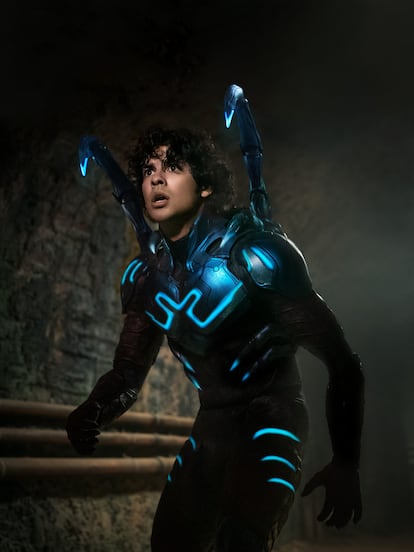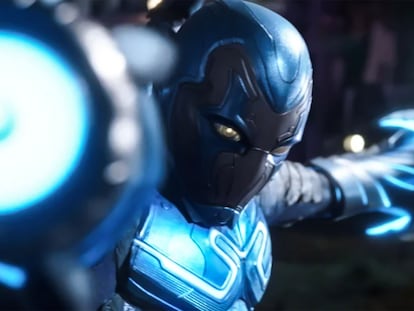Ángel Manuel Soto, director of ‘Blue Beetle’: ‘It is worth investing in telling stories within the Latino identity’
In the newest movie from the DC universe, the Puerto Rican director introduces Jaime Reyes, a superhero of Mexican descent, to the big screen


Who is your favorite superhero? That was the first question that Ángel Manuel Soto and Gareth Dunnet-Alcocer asked themselves. The first is from San Juan, Puerto Rico, and the second from Querétaro, Mexico. Soto remembers, with a laugh, that they both agreed that they still cherish the memory of a yellow heart-shaped shield: “More agile than a turtle. Stronger than a mouse. Nobler than lettuce. His shield is a heart. It’s the Chapulín Colorado.” According to the Puerto Rican filmmaker, the character created by Mexican comedian Roberto Gómez Bolaño, Chespirito, transcended borders.
That connection helped the duo understand how stories can connect everyone in different ways. That idea was the impetus behind the film Blue Beetle, which introduces the character Jaime Reyes, a superhero of Mexican descent, into the DC Comics universe, along with characters such as Superman, Batman and Wonder Woman.
In the film, Jaime Reyes (played by Xolo Maridueña), a recent graduate, returns home full of aspirations for his future, but he discovers that his home is not exactly as he left it. In his quest to find his purpose in the world, fate intervenes when he unexpectedly finds himself in possession of an ancient relic of alien biotechnology: the scarab. When the beetle chooses him as a symbiotic host, he receives an suit of armor with extraordinary powers, turning him into the superhero Blue Beetle.

Soto joined the project during the pandemic. His film Charm City Kings was about to be released, but due to the global lockdown, it could not be shown in theaters. It debuted on the streaming platform on HBO Max. DC Comics was looking for a Latino director, and due to Charm City Kings’ good reception, they approached Soto. Defending and preserving the film’s identity was the most challenging and difficult part, he admits. “Both the creators and the actors wanted to have the freedom to be freely Latino, of not having to explain our Latinness. The most complicated thing was having to explain that over and over again to those who saw that as unnecessary simply because they didn’t understand it,” says Soto.
Apart from Maridueña —an American with a Cuban father and Mexican mother— the film’s cast includes Mexican talent such as Adriana Barraza, Damián Alcázar and Elpidia Carrillo, as well as American actors with Mexican roots, such as George López and Harvey Guillen, and the Brazilian Bruna Marquezine.
The film is peppered with nods to Latin American culture, such as the similarity of Blue Beetle’s suit with the Mexican wrestler Blue Demon, references to the telenovela María la del Barrio, starring Thalía —”an inheritance” from Soto’s grandmother, the director says—, and iconic songs from the continent, such as Nada Personal by Soda Stereo, Cumbia Poder by Celso Piña and even Demolición, by the Peruvian punk rock band Los Saicos.

Although the story portrays a multigenerational Mexican family, the director admits, it was “illogical and absurd” to assume that a single film can include the collective experience of a million people. Soto and Dunnet-Alcocer attempted to find a focus that took into account the responsibility that fell on their shoulders, while capturing the intersections between different Latin cultures.
“We want Blue Beetle to be a letter of introduction to the different ranges of colors that exist within Latinidad, but also for this experience to serve as an example that it is worth investing in telling stories of different demographic groups within the Latino identity, because Latin American experiences are as diverse as our cultures,” adds Soto.
The Blue Beetle character was created in 1939. It has had three different incarnations, with Jaime Reyes the most recent, coming from the minds of Keith Giffen, John Rogers and Cully Hamner in 2006. Since then, the character has appeared in different comics series, television shows and video games. Soto and Dunnet-Alcocer took the best of the character to the film. “There are countless versions of the Blue Beetle, from the Infinite Crisis to the New 52. There are the animations of The Brave and the Bold, Young Justice and the comic Graduation Day, and the fighting moves in the video game Injustice 2, to mention a few. We have a shot with different facets of Jaime Reyes, and Gareth is a total geek for the character. I told him, ‘let’s have fun and make a version with his greatest hits,’” says Soto.
The film comes at a time when the superhero genre seems to be going through a crisis, due in part to an overproduction of films that fans insist do not meet quality standards, as well as a saturation of the genre. Since 2008, the year that Marvel Studios, DC’s competitor, released Iron Man, films have appeared in an incessant stream. The premiere of Soto’s film also coincides with the Hollywood actors and screenwriters strike, which prevents them from promoting any film or series.
Despite the uncertain environment around the movie, its best allies have been the fans, the internet and memes. For months the phrase “Blue Beetle August 18 only in theaters” has crept into all kinds of images and memes. In the United States, 27 groups have issued a letter in support of the film stating that their “stories are universal and need to be told.”
The next few weeks will be key to DC ending the year well, after two of its bets, Flash and Shazam! The Fury of the Gods, have not performed as expected at the box office. Faced with these ups and downs of the genre, Soto believes that the solution is to “bet on art.” “Before thinking about the commercial, authors must be given freedom so that they can express what they want without feeling that they are governed by a corporate shadow. I feel like that’s the way to refresh the genre when you feel stagnant. By doing things differently. Algorithms don’t know everything. Art has much more power than anything else,” he concludes.
Sign up for our weekly newsletter to get more English-language news coverage from EL PAÍS USA Edition
Tu suscripción se está usando en otro dispositivo
¿Quieres añadir otro usuario a tu suscripción?
Si continúas leyendo en este dispositivo, no se podrá leer en el otro.
FlechaTu suscripción se está usando en otro dispositivo y solo puedes acceder a EL PAÍS desde un dispositivo a la vez.
Si quieres compartir tu cuenta, cambia tu suscripción a la modalidad Premium, así podrás añadir otro usuario. Cada uno accederá con su propia cuenta de email, lo que os permitirá personalizar vuestra experiencia en EL PAÍS.
¿Tienes una suscripción de empresa? Accede aquí para contratar más cuentas.
En el caso de no saber quién está usando tu cuenta, te recomendamos cambiar tu contraseña aquí.
Si decides continuar compartiendo tu cuenta, este mensaje se mostrará en tu dispositivo y en el de la otra persona que está usando tu cuenta de forma indefinida, afectando a tu experiencia de lectura. Puedes consultar aquí los términos y condiciones de la suscripción digital.
More information
Archived In
Últimas noticias
Welcome to the post-religion era: The idea of Christianity as the absolute truth has become obsolete
‘I thought you would like it’: The risky sexual practice popularized by TV shows and TikTok
The digitalization of tourism: ‘They promise experiences and gave us the worst possible one’
Mexican peso defies uncertainty with forecasts of a new period of stability in 2026
Most viewed
- Sinaloa Cartel war is taking its toll on Los Chapitos
- Oona Chaplin: ‘I told James Cameron that I was living in a treehouse and starting a permaculture project with a friend’
- Reinhard Genzel, Nobel laureate in physics: ‘One-minute videos will never give you the truth’
- Why the price of coffee has skyrocketed: from Brazilian plantations to specialty coffee houses
- Silver prices are going crazy: This is what’s fueling the rally










































